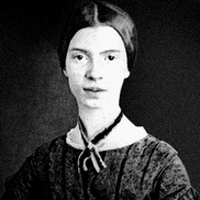If I should Die by Emily Dickinson: Summary and Analysis
Emily Dickinson is one of the greatest American poets, and a death-obsessed writer. Her poems exemplified the truth and hidden humor about death. This famous poem 'If I should Die' contrasts death with the life of the survivors. This has thematic affinity with Robert Frost's 'Home Burial.' Like Frost's poem, this is concerned with the changeless routine of the survivor's world.

Emily Dickinson (1830-1886)
The death of one individual does not matter: the life is for the living. So time keeps flowing incessantly and every element of nature keeps its schedule. Birds continue to build nests and bees don't stop humming. The survivors, the world is business-like and its nature is hinted at by tic word like 'enterprise', 'stocks', 'commerce' and `trades', The last four lines assure us that the awareness of the changelessness of this commercial world makes the dying one experience of a serene tranquility. The survivors can sprightly conduct the business of burial and obsequies.
This poem consists of two parts regarding the circle of life: the first part reveals the natural aspect of life as a very peaceful part, and the second part is portrayed as the human aspect, with more bustling energy.
Dickinson uses morn, noon, the birds and the bees, and the daisies epitomize the peaceful and natural trait of dying in the first part of her poem. Daisies are symbolically signified in the poem because daisies are placed on the graves of loved ones. These daisies referred to the death. She focuses on the natural process of the nature by showing the things of nature following its circle of life. She easily accepts the truth of death as a part of life and does not feel sad on her own death. The existence of each thing in nature has to vanish one day. Moreover, she believes that death is not the end, it is the beginning of the something new and exciting journey.
The second part of her poem deals with another aspect of death and dying. She says after her death all the commerce and trade will continue and people will prosper more. No one and nothing on the earth will worry her death and will not be adversely affected. In this point, Dickinson is not worried rather she is feeling calm and that even after her death the circle of life is naturally going on.
Dickinson takes her death as a normal thing to occur. Her obsession with the death is clearly seen in the poem. Her easy and positive approach to death in this poem reflects her spirituality and defines her as a metaphysical poet. She supports the idea that death should no longer be something that one fears because everything has to die to be something new again and to continue the circle of the life.
Cite this Page!
Shrestha, Roma. "If I should Die by Emily Dickinson: Summary and Analysis." BachelorandMaster, 13 Dec. 2017, bachelorandmaster.com/britishandamericanpoetry/if-i-should-die-summary-analysis.html.
Related Topics
Much Madness is Divinest Sense: Analysis
Renunciation: Summary and Analysis
Because I could not Stop for Death: Analysis
I Heard a Fly Buzz: Summary and Analysis
After Great Pain, a Formal Feeling Comes: Analysis
Success is Counted Sweetest: Summary and Analysis
I taste a liquor never brewed: Summary and Analysis
A Bird came down the Walk: Summary and Analysis
Hope is the Thing with Feathers: Analysis
I like to see it lap the Miles: Summary and Analysis
I had something that I called mine: Analysis
I'm Nobody! Who are you?: Summary and Analysis
These are the days when the Birds come back
What Inn is this: Summary and Analysis
Exultation is the going: Summary and Analysis
Of Bronze-and Blaze: Summary and Analysis
A Clock Stopped: Summary and Analysis
I felt a Funeral, in my Brain: Summary and Analysis
Safe in their Alabaster Chambers: Analysis
There's a certain Slant of light: Summary and Analysis
To fight aloud, is very brave: Summary and Analysis
I like a look of Agony: Summary and Analysis
Bring me the sunset in a cup: Summary and Analysis
The day came slow-till Five o'clock: Analysis
 |
bachelorandmaster.com |